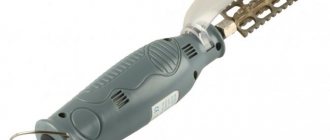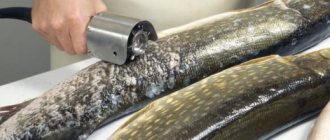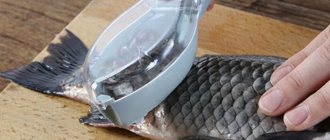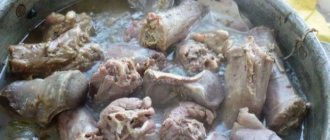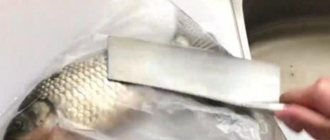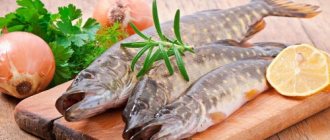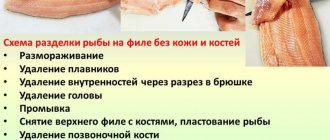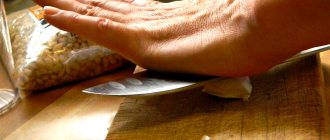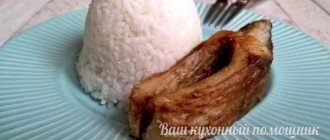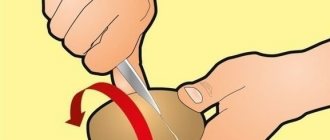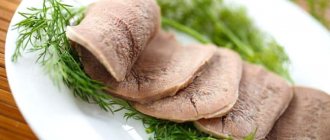Pike perch is a resident of deep reservoirs and today housewives often prepare various dishes with it: boiled or stewed. Before you start cooking fish in any way, the question arises of how to clean pike perch from scales simply and spending literally a few minutes on it.
How would you prefer to cook pike perch?
- Pan fry 45%, 175 votes
175 votes 45%175 votes - 45% of all votes
- Bake or stew 32%, 125 votes
125 votes 32%
125 votes - 32% of all votes
- Smoke 10%, 40 votes
40 votes 10%
40 votes - 10% of all votes
- As first courses 5%, 21 votes
21 votes 5%
21 votes - 5% of all votes
- Salt and pickle 4%, 15 votes
15 votes 4%
15 votes - 4% of all votes
- Other 3%, 12 votes
12 votes 3%
12 votes - 3% of all votes
Total votes: 388
22.07.2020
- Pan fry 45%, 175 votes
175 votes 45%175 votes - 45% of all votes
- Bake or stew 32%, 125 votes
125 votes 32%
125 votes - 32% of all votes
- Smoke 10%, 40 votes
40 votes 10%
40 votes - 10% of all votes
- As first courses 5%, 21 votes
21 votes 5%
21 votes - 5% of all votes
- Salt and pickle 4%, 15 votes
15 votes 4%
15 votes - 4% of all votes
- Other 3%, 12 votes
12 votes 3%
12 votes - 3% of all votes
Total votes: 388
22.07.2020
×
You or from your IP have already voted.
Why don't people like to clean fish?
Fishermen love to fish for sport; many prefer tasty fillets, but few people like to clean fish. The scales fly all over the kitchen, the bones dig into the skin, and the gall bladder tries to get on the edge of the knife and ruin the taste.
The predator is distinguished by large fang-shaped teeth on its jaw. Outwardly, it looks like a pike, which has the same elongated head with a wide mouth with sharp teeth. On the back there are hard and spiny fin rays with dark speckles and gill covers. You can get hurt when cutting fish.
It takes root in ecologically clean reservoirs, like bream, but river specimens can sometimes smell like mud. In addition to the unpleasant odor, there is mucus, which makes processing more difficult. Before cutting the fish, rinse it under the tap or rub it with coarse salt to get rid of mucus and unpleasant odor.
Siberia is the birthplace of modern pike perch, as evidenced by DNA examinations of the discovered remains. Centuries-old evolution has not affected the appearance in any way. The body shape has not changed, but the same cannot be said about the habitat. In addition to Siberia, it has taken root in water bodies of both hemispheres of the planet. The marine, common and Volga subspecies are found on the territory of the Russian Federation.
Pike perch is an ordinary fish, but healthy
It’s not difficult to recognize pike perch on store shelves. An elongated body and a pointed nose, slightly reminiscent of the culinary favorite - pike. A greenish-brown back, brownish-gray spots on the sides and a white belly - this is the color of our hero. Spots on the sides most often form a beautiful pattern consisting of 8–10 regular stripes. But the fins are dotted with dark spots, reminiscent of leopard print. Its jaws are powerful, with rows of fang-like teeth.
True, in the South-West of our country there are also dark species belonging to the black color. Apparently, the fish acquires this color due to special climatic conditions. Attempts by scientists to move light-colored specimens into lakes with this type of pike perch led to the fact that after a couple of months the color of the fish changed to dark. It is easy to distinguish a regular one from a dark one: it has a much lighter color.
The following species are found in nature:
- lightfin,
- ordinary,
- Volzhsky,
- sandy,
- nautical.
Shop windows usually display small specimens ranging from 1 to 3 kg and 30–50 cm in length. But adult pike perch, living 8–10 years, can reach 150 cm in length and 18 kg of live weight. If we immediately imagined what size this fish would be in another 10 years, we would be disappointed: fish live up to 14 years. And weight more than 7-8 kg is more the exception than the rule.
Adult pike perch can weigh up to 18 kg
Although pike perch is considered a common, non-exotic fish, it is incredibly healthy. Firstly, its meat has a low calorie content: only 84 kcal per 100 g, and secondly, it completely lacks carbohydrates, unlike other freshwater ones. Thirdly, it contains a large amount of vitamins B, C, E as well as potassium, magnesium, iron and other trace elements. This fish, when eaten, has a very positive effect on the functioning of our brain and nervous system, not to mention taste buds.
Nutritional value and composition
100 g of pike perch contains up to 35 mg of calcium, 25 mg of magnesium and 230 mg of phosphorus, which is necessary for the healthy development of our body.
As already mentioned, the composition contains no carbohydrates, and the nutritional value is: proteins - 88%, fats - 12%.
When and how to clean pike perch - advice from professionals
Freeze or cook the semi-andromous carnivore immediately, otherwise it will spoil quickly. Cleaned carcasses without giblets can be stored in the refrigerator for up to 2 days, and fresh ones, ungutted, can be left for only a few hours. Extend shelf life by peeling, gutting and rinsing inside and out. After freezing it retains its taste.
About cutting pike perch
Fish is cut differently depending on the method of heat treatment. In any case, you stuff it or cut it into steaks, you will have to clean the fish with small scales, cut off the pointed fins and remove the insides. If served whole, leave the head and tail stem. When the filleting of the pike perch is finished, they are disposed of. Stuffed carcasses are served without bones, which are first removed.
First, decide on the recipe and start cutting the fish in the following order:
- cut off fins and gill spines;
- rub with salt to get rid of mucus;
- remove scales and, if necessary, skin;
- gut by ripping open the abdomen, removing the giblets and removing the fatty film on the inner surface;
- cut the pike perch fillet with skin and rib bones or cut into pieces.
Before cleaning the fish, prepare your kitchen utensils for cleaning walleye.
Skinning pike perch fillets
At the final stage of filleting, cut the skin from both layers of large pike perch, holding it with a fork (photo 6).
After removing the skin from the fillet, all that remains is to remove small bones from the flesh with tweezers and rinse the layers of fish.
Fillet after complete cutting of large pike perch is more suitable for preparing rolls, minced meat for cutlets, zraz, pates, pies and similar dishes. See Pike perch in a beet log.
How to clean pike perch from scales and how to cut it?
Any housewife knows: when processing a carcass, scales fly everywhere. Prepare the area before filleting the fish. If this is not done, you will have to wash not only the table, but also the dishes and furniture.
To clean fish you will need:
- a board made of wood or plastic of a suitable size;
- a sharpened fillet knife, which has a long, flexible and thin blade that maneuvers through the pulp;
- kitchen scissors for removing fins, gill spines and membranes and cutting stubborn bones;
- a kitchen hatchet to remove the head and tail of larger specimens and cut them into small pieces.
Instead of a sharp blade, you can use a special fish scaler, grater or spoon. The scraper can be in the form of a garden hoe or versatile rows of teeth. It evenly captures the scales without damaging the pulp. You can buy a fish scaler or make one yourself. You will need a small block to which caps with pointed edges from glass bottles are nailed. Use an old grater or tablespoon. Use what is convenient for you.
Cleaning with a household car wash
This is one of the most effective methods. True, you won’t be able to use it in an apartment, but in a dacha it’s fine.
Follow safety precautions. Contact with hands may cause injury.
Algorithm of actions:
- Place the fish on a flat surface.
- We spray it with a high-pressure jet from tail to head (the scales should fly off instantly).
- We turn the fish with the other side up and repeat the procedure.
The stream should pass over the fish quickly. Otherwise, there is a high risk of turning the fish into minced meat.
To make the process safer and more convenient, you can make a special clamp on plywood. We fix the fish using a fastener and spray it with a stream.
How to clean fish from scales so that they do not fly around?
Frost-Fish has collected lifehacks that will save you from cleaning the kitchen after cleaning the pike perch. Choose any convenient option from those offered, especially since you will have everything you need in the house and will not need to buy anything additional.
Ways to simplify processing:
- Plug the kitchen sink drain and add enough water to cover the carcass. Do not use too much so that the drops do not splash while cleaning.
- Fill a deep bowl or basin and remove the scales, as in the previous version.
- Place the cutting board in a large bag and clean.
- Pour boiling water over both sides or immerse in hot water for a few minutes, holding it by the tail. Do not leave in boiling water for too long if skin is needed.
- Soak for 1 hour in a water-vinegar solution. Add 2 tbsp to 1 liter of water. l. vinegar. Processing will not only be easier, but it will also be easier for you to get rid of the unpleasant smell of mud.
- Place in the freezer for 1 hour. Cleaning frozen fish is much easier than fresh fish. When freezing fresh walleye, don't be alarmed if it moves as it thaws.
Choose 1 of 5 methods and feel the difference if you previously removed scales under a tap or on an uncovered cutting board.
Scald the carcass with boiling water
Probably the most difficult thing in processing pike perch is separating the scales. It belongs to the perch family. All representatives of this genus are notable for their small but hard scales. Sometimes the perch is not even scaled at all. It's too much hassle.
Let's look at another interesting life hack. Many housewives actively use it. Before cleaning, the fish is placed in boiling water and scalded for a couple of minutes.
You can put fish in water only after bringing it to a boil.
Keeping prey in boiling water for a long time can cause the scales to separate along with the skin. Therefore, the main thing is not to overdo it.
The boiled fish can be cooled under the pressure of cold water and then proceed to cleaning. A knife or scraper will do as a tool.
Processing fish at home always leaves a lot of dirt in the kitchen. To minimize contamination, it is recommended to clean the predator in water, then the scales will scatter less, or to process it by placing it in a plastic bag.
Rules to help clean fish
When cleaning pike perch, follow several rules so as not to spoil it, preserve nutrients and cook deliciously. All its parts are edible, except the insides. You can even cook pike perch cheeks - the signature dish of avid fishermen who believe in the legend.
According to legend, the fisherman who caught it must eat the cheeks of a trophy pike perch. Small pieces of meat are delicious according to gourmets. They believe that there is a magical substance in the cheeks that brings good luck on future fishing trips. Eaten zander cheeks will give fishermen many trophies.
If you are not going to try pike perch cheeks, but plan to cook whole or cut steaks, then adhere to the following rules:
- Remove the dorsal fin and gill spines first.
- Cut off the head and tail after removing the scales.
- Cut the belly so that the knife goes inside 0.5 cm and no more.
- Remove the giblets carefully to avoid damaging the gallbladder. It is located next to the liver. Keep in mind that the gallbladder is approximately located between the pectoral and pelvic fins. When cutting, slowly move the blade from the middle of the belly to the head so as not to catch it.
If you pierce the membrane of the gallbladder with a knife, the bile will spoil the taste. The places where it got into are cut off and washed well.
Don't throw away the head, tail and dorsal fin, but freeze them. These are excellent ingredients for soup, aspic and fume - a rich broth to which gelatin is added at the rate of 30-40 g per 1 liter of broth.
What you need for work
Before cleaning your pike perch, prepare the following:
- A regular grater that you use to process vegetables. Mostly every housewife has this equipment. Before use, the grater is slightly bent and threaded onto the handle. This way the cleaning will be more effective.
- Scraper. If you don’t have this tool, you can buy it at a hardware store. If you like to craft, then make a scraper with your own hands. The basis for it will be an ordinary wooden spatula. Attach metal beer caps to it. Caps from 0.5-liter lemonade bottles will also work. They are mounted in such a way that the sharp edges are turned outward. To prevent the caps from flying off, use screws as fasteners. In general, you will become the owner of a homemade device, which in the future you will be able to clean not only pike perch, but also any other fish.
- Water.
- Scissors.
- Several plastic bags. Regular film will also work.
You will also need some old newspapers. They need to cover the table. Otherwise, it will be dirty and saturated with unpleasant odors. You will have to work in thick rubber gloves.
How to remove a dorsal fin?
The representative of the spiny-feathers strives to injure his hands. Trim the dorsal fin with scissors or cut with a sharpened knife. It is removed along with the subcutaneous layer of fat, and not at the level of the back. If you hold the scissors to the skin, you will only cut off the top part. You need to cut out the fin base by cutting the subcutaneous layer on both sides with a fillet knife.
When processing large specimens, special forceps are used. First, cuts are made in the same way on the left and right, and then the fin base is removed with forceps.
The pelvic and pectoral fins are smaller than the dorsal fins, so they are much easier to remove. It is enough to cut them off along with a small subcutaneous layer of fat.
Features for added convenience and safety
We recommend using thick rubber gloves to help protect your hands from injury.
If you have a lot of cleaned fish and there is a question about storing it, we recommend using a vacuum sealer that pumps out the air and seals the tightly packed product package.
The advantages of this method are obvious: the fish does not air out, does not absorb foreign odors and can be stored in the freezer without loss of quality for much longer.
How to clean fish from scales correctly?
Do not cut off the head and tail until you have completely trimmed the whole carcass, which is easier for the blade to move along. If you remove them, it will not be comfortable to hold on to, and you can damage the skin in the tail part.
Whatever you use to cut it, remove the scales from the tail to the head. It is convenient for some to start directly at the base of the tail, moving gradually upward, while for others, on the contrary, it is easier to start near the gills and move towards the tail. Choose any direction in cleaning the pike perch from scales, the main thing is that the knife should move against the growth, and not vice versa.
If you clean the carcass not in a filled bowl, but on a cutting board, secure it. Place it on a board and pierce the eyes with a small knife, sharp fork or awl. Fresh fish will not flutter or move when cut.
Once pinned to the cutting board, pull firmly on the tail. A crash should be heard. After this, it will be easier for you to remove small scales that are tightly pressed together.
If you are right-handed, place the fish so that the tail part is under your left hand. Hold it with your hand and move the knife from left to right. If you are left-handed, then turn it over to the other side.
You can insert a ballpoint pen or pencil into the fish's mouth to immobilize it and make it easier to hold. This option is convenient when cleaning by weight.
To prevent the fish from slipping out of your hands, dip your palms in salt or wrap it in a paper towel. If you have allergies, you may experience irritation. Most often, allergy sufferers cook not for themselves, but for their family or at work. Before removing any fins or scales from a walleye, wrap it in a cotton kitchen towel to avoid touching it. You can also do this if you don’t have a food allergy, but your hands are cut or you have sensitive skin. Avoid direct contact to avoid irritation.
Peel one side first and then move on to the other. After cleaning the pike perch from scales, run the blade over the carcass again.
Can also be cleaned with a household car wash. The method is non-standard, not accessible to everyone, but effective. Portable high-pressure washers are convenient to use in the countryside or in nature. The scales “fly off” under a strong stream. Place the carcass on a flat surface and spray it with a stream, having previously adjusted the pressure and keeping a distance so as not to wet your feet. The stream should hit the tail and gradually rise upward.
Remove scales with a spoon
Another simple and effective way to separate scales. For this you will need a very ordinary tablespoon. First, wash the fish well and then place it on the board. With one hand we hold the spoon with the notch up, and with the other we hold the fish itself.
With smooth rhythmic movements we move from the tail to the head. The scales are pryed off with the edge of the cutlery and are easily removed. With small individuals this method will be less effective.
Denis Borisov
Assistant chef of the restaurant "Fisherman's House"
Ask a Question
Housewives recommend freezing fish first. After taking it out of the freezer, let it rest for 1 hour and then start cleaning. Defrosting will loosen the stubborn scales.
How to rip open the belly?
The fish is cut open to remove the insides and also to stuff it. Using scissors or a sharpened knife, cut the belly. Make a longitudinal cut from the anal fin to the gill covers. Cut out the gill flesh and remove the cartilaginous bridge, then pierce the belly and make an incision.
Remove the giblets along with the gills, after cutting off the area of skin next to them. The belly of small carcasses does not need to be ripped open. It is enough to make deep cuts near the gills, and when you remove the head, take it out along with the giblets.
If you are going to stuff a large specimen, make an incision from the back near the anus to the anus.
The main thing is not to touch the gallbladder, otherwise a thorough flushing of the inner lining of the abdomen will be required.
How to fillet fish correctly?
Remember, before you fillet the fish, you do not need to cut off the head and tail. They help hold the carcass during processing and allow you to get a beautiful pike perch fillet without torn edges. It is served fried or baked. It is breaded and dipped in batter. After you fillet the fish, you can freeze it or leave it in the refrigerator for a couple of days.
Gutted fish are cut without fins and gills, but with a tail and head. First, the subcutaneous fat is cut from the base of the pectoral fin to the ridge. The perpendicular cut should be a short distance from the gills. Then, without separating the heads, layer them alternately on both sides.
You need to insert the blade into the cut made so that it is parallel to the ridge. Then run the knife along the ridge towards the tail. If it gets stuck, it means the blade is catching on the ridge. In this case, lift it a few millimeters and continue moving closer to the tail. The result should be 2 parts, one of which is without a ridge, and the other with it.
When cutting the fish is finished, you need to remove the bones from the second fillet. Place the carcass half, skin side down, on a cutting board. Use a sharp thin knife to pry up the ridge. Insert a wide-bladed knife between the ribs and the flesh. Then carefully separate the flesh from the ridge, pressing down the pike perch and gradually moving closer to the tail.
After processing, cut off the tail and head. If necessary, cut into portions or cook individually. Knowing how to clean filleted pike perch, you can buy it fresh, not frozen, or cook your catch.
How to properly prepare for stuffing
- Cut off the fins with kitchen scissors.
- We clean the carcass from scales.
- From the side of the belly we do not completely cut the head, while cutting the spinal bone.
- Using your fingers, carefully separate the skin from the meat and remove it towards the tail.
We remove the skin with a “stocking”
We recommend cleaning fish with work gloves to avoid injury to your hands.
Using the tips outlined above and acquiring skills in cleaning and cutting up pike perch, you can quickly cope with this procedure without spending a lot of effort. Let dishes made from this tasty and healthy fish become a frequent guest on your table.
Today, according to sociologists, one of the most favorite hobbies of Russians is fishing as a good way to take a break from the bustle of the city, and at the same time catch the desired fishing trophy (well, so that you can later show off to your fellow fishermen). But if almost all men love to fish, then not everyone can master the ability to clean it properly. Some “delegate” this process to their family: wives, mothers, daughters.
They say, I brought the booty, and preparing it is your woman’s business. Thus, housewives may find themselves in shock: how to clean pike perch, perch or other fish with a minimum of effort, because some species have scales that are difficult to cut? And that's putting it mildly!
What kind of pike perch can be stuffed?
The river predator has thick and durable skin, like a pike. It is stuffed with its own meat with the addition of crushed bread, fried onions, salt, pepper, and seasonings. It is not necessary to remove the skin with a stocking to stuff the carcass. Having taken everything out along with the entrails, it is stuffed with minced fish, the cut is “sewn together”, baked and served as a cold appetizer or a hot dish. It is best to stuff live and chilled carcasses that have not been frozen. Low temperatures damage the skin structure. It becomes weak and breaks when cooked.
Pike perch - a delicious gourmet dish
A perishable predator must be cooked immediately or frozen after cutting it up. You can either improve the taste or ruin it. To test freshness, place the pike perch in a bowl of water. The fresh one will sink, but the rotten one will float.
The river predator is lean, so it is served with sauce. In cooking, there are many different dishes made from pike perch, which can be subjected to various heat treatments. After peeling and cutting up the pike perch, salt the pieces and fry them only after 15 minutes. This method will prevent it from falling apart into fibers. Place the pieces in a heated frying pan, greased with a mixture of vegetable and butter. Place them at a short distance to make it easier to turn them over. Add a pinch of salt to the hot oil if you want crispy steaks.
If you cook pike perch fish soup, salt the water until it boils. Add several different fish to the broth to make it rich and tasty. Do not cook it with carp, bream, eel and lamprey, which will give the tender meat a bitter taste. You can make pike perch pies by gutting, cleaning, slicing and seasoning with salt, pepper and onion.
In the Russian Empire, the river predator never became noble, but was valued on a par with representatives of the Salmon and Sturgeon families. The collection of recipes from the culinary literature classic Elena Molokhovets contains about 30 dishes, most of which are made from boiled meat. In the second half of the 19th century, the Austro-Hungarian emperor was supplied with pike perch caught in the Volga.
With salt
Another interesting and fairly easy cleaning method that housewives respond positively to. Salt is known to corrode organic tissue. This makes it easy to remove the protective cover of the prey.
- Wash the fish thoroughly.
- We separate the fins to avoid injury.
- Dry the prey with napkins or a paper towel.
- Pour salt into a bowl or baking tray (do not skimp on the salt).
- We carefully coat each fish in salt on all sides (it should be densely covered with salt).
- Place in the refrigerator and wait 10 – 15 minutes.
- After this, the scales will be separated even with bare hands, like a stocking. What will remain is clean meat.
There is no need to add additional salt to the fish before cooking, since it has already absorbed the seasoning.
The benefits and harms of pike perch
The river predator is recommended for young children, the sick and overweight people. Rich in protein, amino acids, minerals and vitamins. Contraindicated in case of individual intolerance or allergy to fish protein.
Helps normalize the functioning of the cardiovascular, endocrine, musculoskeletal and digestive systems. Participates in the formation of red blood cells, stabilizes cholesterol levels, destroys blood clots, prevents blockage of blood vessels, reduces the risk of stroke and heart attack.
Useful for children during puberty, promotes physical and mental development. Pediatricians recommend introducing it into the first complementary foods at the age of 9-10 months. Give half a teaspoon of fish puree; if there is no allergic reaction, gradually increase the proportion.
The sulfur content promotes the absorption of amino acids and nutrients, improves the condition of hair, nails, skin and musculoskeletal tissue. Chromium removes toxins and normalizes blood sugar. Potassium increases endurance, replenishes vital energy and reduces swelling. Fluorine and phosphorus relieve fatigue and have a beneficial effect on the nervous and cardiovascular systems. Iodine normalizes metabolism and thyroid function. Cobalt improves digestion and absorption of food, strengthens the immune system, and restores damaged cells. Vitamin PP stimulates the functioning of the central nervous system.
The river predator is a commercial species.
It has a rich vitamin and mineral complex that promotes speedy recovery after illness, normalizing the vital functions and functioning of various internal organs. It is processed with various cutting and sharp tools to prepare cold and hot appetizers, delicious soups and main dishes with various sauces and side dishes. Return to list
How to cook minced pike perch cutlets in the oven
An easy way to cook delicious pike perch cutlets in the oven.
Ingredients:
- Pike perch fillet – 500 gr.
- Bulb.
- Milk – 100 ml.
- Sour cream – 2 large spoons.
- Bread crumb, pepper, salt.
Cooking:
- Rinse the fillet and pass through a meat grinder. Divide the onion into 4 parts, chop after the fish.
- Do the same with the soaked bread crumb, after soaking it in milk.
- Mix all the products, beat in the egg, season with spices.
- Make the balls and place them in a greased heat-resistant form.
- Pour sour cream on top.
- Bake pike perch cutlets at a temperature of 200 o C, turning on the timer for 20 minutes.
